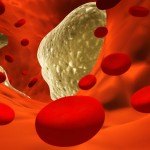 Fat outside of arteries, especially outside the left coronary artery, may influence the formation of coronary artery disease, according to new research from the University of Cincinnati. Coronary artery disease develops when the coronary arteries, which are the major blood vessels that supply the heart with blood, oxygen and nutrients, become damaged or diseased. When plaque builds up, the arteries narrow, causing the heart to receive less blood. In time, diminished blood flow can lead to chest pain, shortness of breath or a heart attack if a complete blockage occurs. Coronary artery disease is a leading cause of death in the United States.
Fat outside of arteries, especially outside the left coronary artery, may influence the formation of coronary artery disease, according to new research from the University of Cincinnati. Coronary artery disease develops when the coronary arteries, which are the major blood vessels that supply the heart with blood, oxygen and nutrients, become damaged or diseased. When plaque builds up, the arteries narrow, causing the heart to receive less blood. In time, diminished blood flow can lead to chest pain, shortness of breath or a heart attack if a complete blockage occurs. Coronary artery disease is a leading cause of death in the United States.
By measuring the activity of thousands of genes at once – called a global gene expression analysis – UC researchers found that perivascular (outer) fat tissue is different from the fat tissues in other parts of the body. It has been proposed that dysfunctional perivascular fat is to blame in the onset of coronary artery disease; research has shown that in people with coronary artery disease, the fat tissue is highly inflamed.
The researchers replicated the inflammation in an animal model. They found that the closeness of the perivascular fat to the artery easily influences the function of the coronary blood vessel wall. Lead researcher Tapan Chatterjee, PhD, explained that the findings showed that perivascular fat is especially sensitive to a high-fat diet, and induced inflammatory changes in their animal models. Specifically, when they transplanted perivascular fat from obese mice to the carotid artery of lean mice, the tissue was detrimental to the blood vessel wall and quickly led to disease formation. “We believe this cross-talk between perivascular fat and the coronary artery is very important in triggering coronary artery diseases,” said Chatterjee.
Next, the team plans to identify various secreted factors, or signals, from perivascular fat tissue of obese mice that could negatively influence the functions of the blood vessel wall. Their goal is to be able to use this research to treat patients before they experience the onset of coronary artery disease. This new research was presented at the American Heart Association’s Arteriosclerosis, Thrombosis and Vascular Biology Annual Meeting last month.
Related Reading: Earlier in 2012, a study of 4,000 obese adults was published, showing that there are fewer heart attacks after bariatric surgery. You can read about that study here.






Nutrition & Lifestyle